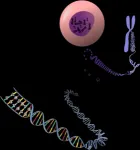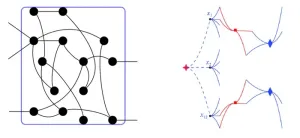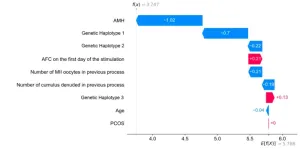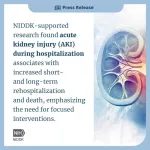(Press-News.org) CHAPEL HILL, N.C. – Hundreds of scientific studies have been conducted over the years to find the genes underlying common human traits, from eye color to intelligence and physical and mental illnesses.
Patrick Sullivan, MD, FRANZCP, the Yeargan Distinguished Professor of Psychiatry and Genetics at the UNC School of Medicine, and the Psychiatric Genomic Consortium have produced a new packet for the journal Science, to give researchers another way to understand human disease, using the power of evolutionary genomics.
“This is a tool that can give us a lot of important hints about human disease,” said Sullivan, who is also a professor at the Karolinska Institute in Stockholm, Sweden. “If we can take a deep dive into your genome, we can get some idea about your ancestors, both human and nonhuman, and observe the impacts of many millions of years of evolution in you.”
What Makes Us Mammals
Every single living organism on the planet has DNA. The self-replicating material acts as a blueprint for producing certain molecules in organisms, such as proteins. It’s no surprise that humans and our closest relatives, chimpanzees, share 98.8% of genetic material.
While some of our genes have evolved over time, others have remained the same throughout the entire mammalian evolutionary process. In scientific terms, these are called “highly constrained” genes. Some human genes have a surprising amount of genetic similarity in mice, cows, dogs, cats, bats, and dolphins in many regions of the genome.
These are the genes that unite us as mammals. Since these genes have undergone a "trial by fire" throughout evolutionary history, these unaltered genetic regions must play a fundamental role in the health and genetic makeup of the organism, according to Sullivan.
“Some highly constrained genes can make proteins that are nearly identical in us and in a mouse,” said Sullivan. “That's crazy because we have probably 60 million years of evolution between us and the mouse. And yet, this protein hasn’t changed so we infer that this protein is doing something really important.”
It might be simpler to see the work of our shared genes when we zoom out to take a more holistic view.
Humans and other mammals share anatomical structures, such as the four-chambered heart, lungs, hair (or fur), skeleton, and milk-producing mammary glands. We also share similar fundamental processes on a smaller scale, including embryology, how cells grow and divide, and the development and operation of the synapses that transmit neurological chemicals throughout our bodies and brains.
All of which are formed through our shared genetic regions. So, if one of these genes that make up the basics of a mammal is altered or deleted, it could have negative effects on the organism.
A New Way to Look at Human Mental and Physical Health
If a patient has a neurological brain disorder or certain psychiatric disorders, researchers are able to trace it back and see that this person has received a “big hit” to one of the highly constrained genes that are critical to the nervous system, brain structure, or synapses.
Many researchers have relied on the genome-wide association study (GWAS) to find where the genetic risk for a disease is located in the genome. Using genomic techniques and large-size samples, researchers can analyze the entire genome of many populations to find genetic variations, such as single nucleotide polymorphisms (SNPs), associated with a disease or a trait.
Even though it is important to know where these variations are located in the genome, it's also useful to know how or why these genetic variations happened in the first place. Sullivan hopes that other researchers will make use of the new and extensive document to reach their own conclusions regarding the genetics underlying a variety of human diseases.
“As it turns out, a lot of brain traits are actually highly conserved,” said Sullivan, who serves as director of the UNC Suicide Prevention Institute in the Department of Psychiatry. “This research project has really given me a much, much deeper understanding of the genome and how the genome is set up. I now use this all the time in trying to understand schizophrenia, suicide, depression, and eating disorders.”
What This Means for Future Research
As one can imagine, the successful development of a human requires heavy lifting from proteins and DNA sequences. There are two short regions within our DNA, called regulatory enhancers and regulatory promoters, which play especially important roles in regulating our DNA.
The creation of a human gene is similar to a factory that produces donuts. Regulatory enhancers are responsible for controlling the amount of dough squeezed out of the machine and onto the baking tray. Promoters, on the other hand, are in control of when the dough is being squirted onto the tray. At the end of the day, you have a full formed gene.
Researchers like Sullivan may be able to go into the DNA sequences and increase or decrease these regulatory enhancers and promoters to affect the amount of proteins produced by genes, with the goal of lessening the effects of a genetically based disease.
“It might be possible to hit the upstream part that controls it, in a very soft way, to see if that actually helps,” says Sullivan.
END
Mammalian evolution provides hints for understanding the origins of human disease
UNC School of Medicine’s Patrick Sullivan, MD, FRANZCP, and a team of scientists in the Psychiatric Genetic Consortium have created a new manual researchers can use to learn more about the origins of human diseases with high genetic risk.
2023-04-27
ELSE PRESS RELEASES FROM THIS DATE:
How dormant bacteria come back to life
2023-04-27
Solving a riddle that has confounded biologists since bacterial spores — inert, sleeping bacteria — were first described more than 150 years ago, researchers at Harvard Medical School have discovered a new kind of cellular sensor that allows spores to detect the presence of nutrients in their environment and quickly spring back to life.
It turns out that these sensors double as channels through the membrane and remain closed during dormancy but rapidly open when they detect nutrients. Once open, the channels allow electrically charged ions to flow out through the cell membrane, setting in motion ...
Collaborative and creative policies needed to maximize psychedelics’ therapeutic potential
2023-04-27
HOUSTON – (April 27, 2023) – Research supports the promise of psychedelics in treating conditions like depression and post-traumatic stress disorder, but the future regulatory landscape for these drugs remains unclear. Experts from Baylor College of Medicine, the University of Pennsylvania, American University and Harvard Law School call for creativity and collaboration at the federal and state levels in developing policies for the use and oversight of psychedelics and a commitment to developing a strong evidence base for efficacy and safety.
In a paper published in the journal Science, the authors, experts in bioethics, law and ...
Fish’s growth is not reduced by spawning
2023-04-27
Contrary to what is stated in biology textbooks, the growth of fish doesn’t slow down when and because they start spawning. In fact, their growth accelerates after they reproduce, according to a new article published in Science.
“Fish don’t have to choose between growth or reproduction because, in the real world, they don’t occur simultaneously but rather sequentially,” says University of British Columbia (UBC) fisheries researcher Dr. Daniel Pauly, co-author of ...
Local holographic transformations: tractability and hardness
2023-04-27
Counting problems arise in many different fields, e.g., statistical physics, economics and machine learning. In order to study the complexity of counting problems, several natural frameworks have been proposed. Two well studied frameworks are counting constraint satisfaction problems (#CSP) and Holant problems. For counting satisfaction problems over the Boolean domain, two explicit tractable families namely and , are identified; any function set which is not contained in these two families is proved to be #P-hard. Furthermore, counting CSPd is the counting constraint satisfaction problem restricted to the instances where every variable occurs a multiple of d times. The team ...
IVF procedures can be improved by combining genetic and clinical data to predict the number of eggs retrieved in patients undergoing ovarian stimulation
2023-04-27
IVF procedures can be improved by combining genetic and clinical data to predict the number of eggs retrieved in patients undergoing ovarian stimulation.
####
Article URL: https://journals.plos.org/ploscompbiol/article?id=10.1371/journal.pcbi.1011020
Article Title: Personalized prediction of the secondary oocytes number after ovarian stimulation: A machine learning model based on clinical and genetic data
Author Countries: Poland
Funding: The research was co-financed by the European Regional Development Fund under the ...
NRG Oncology study results confirm conventional external beam radiotherapy should remain standard of care in treating localized vertebral metastases of the spine
2023-04-27
Results from the NRG Oncology RTOG 0631 clinical trial comparing stereotactic vs. conventional radiotherapy for localized vertebral metastases of the spine did not meet its primary endpoint. Data from the study suggests that radiosurgery was not considered superior in terms of pain responses at 3 months following treatment, and even displayed worse pain response, than the conventional external beam radiotherapy (cEBRT). These results were recently published in the JAMA Oncology.
cEBRT is currently the standard of care for treating ...
Being hospitalized with acute kidney injury may increase risk for rehospitalization and death
2023-04-27
A study supported by the National Institutes of Health found that people who experienced acute kidney injury (AKI) during a hospitalization, including those admitted with AKI or who developed AKI in the hospital, were more likely to revisit the hospital or die shortly after discharge, compared to people hospitalized without AKI. AKI is a sudden loss of kidney function that usually lasts for a short time. The research, funded by NIH’s National Institute of Diabetes and Digestive and Kidney Diseases (NIDDK), was ...
Inflammation and cancer: Identifying the role of copper paves the way for new therapeutic applications
2023-04-27
Inflammation is a complex biological process that can eradicate pathogens and promotes repair of damaged tissues. However, deregulation of the immune system can lead to uncontrolled inflammation and produce lesions instead. Inflammation is also involved in cancer. The molecular mechanisms underlying inflammation are not fully understood, and so developing new drugs represents a significant challenge.
As far back as 2020, Dr. Raphaël Rodriguez, CNRS research director and head of the Chemical Biology team at Institut Curie (Equipe ...
Newly developed hydrogel nanocomposite for the mass production of hydrogen
2023-04-27
A research team led by Prof. HYEON Taeghwan at the Center for Nanoparticle Research within the Institute for Basic Science (IBS) in Seoul, South Korea has developed a new photocatalytic platform for the mass production of hydrogen. The group’s study on the photocatalytic platform led to the development of a floatable photocatalytic matrix, which allows efficient hydrogen evolution reaction with clear advantages over conventional hydrogen production platforms such as film or panel types.
The importance of alternative energy has recently increased due to global challenges such as environmental ...
New study may advance use of spinal cord stimulation for chemotherapy-related pain and cancer treatment
2023-04-27
FOR IMMEDIATE RELEASE
Researchers at Johns Hopkins University School of Medicine say they have evidence from a new study in rats that spinal cord stimulation (SCS) may be useful in reducing chronic pain in people undergoing active treatment with a common anti-cancer drug.
The study found that the use of SCS measurably reduced pain response in rats that were implanted with human lung cancer tissue — without compromising effectiveness of treatment with paclitaxel, a drug used to treat a variety of cancers.
The study, published April 11 in Neuromodulation: Technology at the Neural ...
LAST 30 PRESS RELEASES:
Researchers find promising new way to boost the immune response to cancer
Coffee as a staining agent substitute in electron microscopy
Revealing the diversity of olfactory receptors in hagfish and its implications for early vertebrate evolution
Development of an ultrasonic sensor capable of cuffless, non-invasive blood pressure measurement
Longer treatment with medications for opioid use disorder is associated with greater probability of survival
Strategy over morality can help conservation campaigns reduce ivory demand, research shows
Rising temperatures reshape microbial carbon cycling during animal carcass decomposition in water
Achieving ultra-low-power explosive jumps via locust bio-hybrid muscle actuators
Plant-derived phenolic acids revive the power of tetracycline against drug-resistant bacteria
Cooperation: A costly affair in bacterial social behaviour?
Viruses in wastewater: Silent drivers of pollution removal and antibiotic resistance
Sub-iethal water disinfection may accelerate the spread of antibiotic resistance
Three in four new Australian moms struggle with body image
Post-stroke injection protects the brain in preclinical study
Cardiovascular risk score predicts multiple eye diseases
Health: estimated one in ten British adults used or interested in GLP-1 medications for weight loss
Exercise to treat depression yields similar results to therapy
Whooping cough vaccination for pregnant women strengthens babies’ immune system
Dramatic decline in new cases of orphanhood in Uganda driven by HIV treatment and prevention programs
Stopping weight loss drugs linked to weight regain and reversal of heart health markers
Higher intake of food preservatives linked to increased cancer risk
Mass General Brigham–developed cholera vaccine completes phase 1 trial
First experimental validation of a “150-year-old chemical common sense” direct visualization of the molecular structural changes in the ultrafast anthracene [4+4] photocycloaddition reaction
Lack of support for people on weight loss drugs leaves them vulnerable to nutritional deficiencies, say experts
Dogs’ dinners can have greater climate impact than owners’
Are you ready to swap salmon for sprats and sardines?
1.6 million UK adults used weight loss drugs in past year
American College of Cardiology comments on new dietary guidelines for Americans
American Society of Gene & Cell Therapy and Orphan Therapeutics Accelerator partner to advance and commercialize promising rare disease treatments
One in 14 patients having day case surgery have new or worse chronic pain 3 months after their operation
[Press-News.org] Mammalian evolution provides hints for understanding the origins of human diseaseUNC School of Medicine’s Patrick Sullivan, MD, FRANZCP, and a team of scientists in the Psychiatric Genetic Consortium have created a new manual researchers can use to learn more about the origins of human diseases with high genetic risk.





